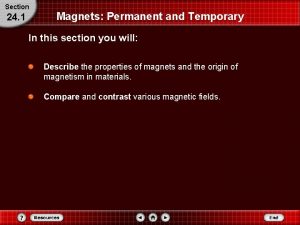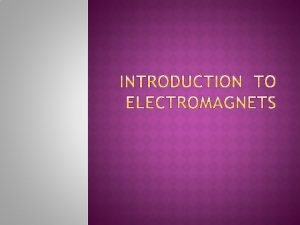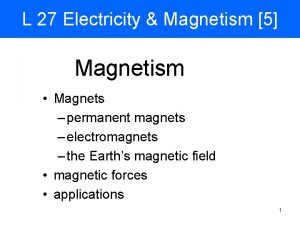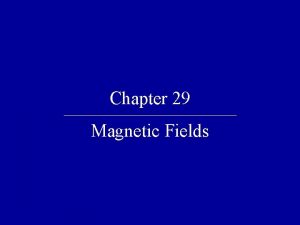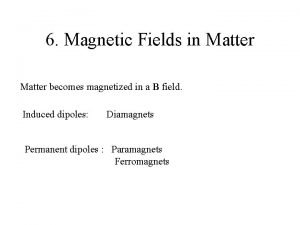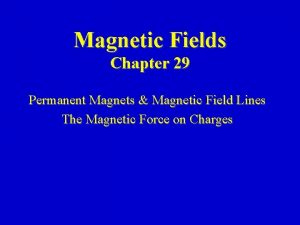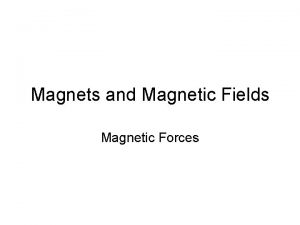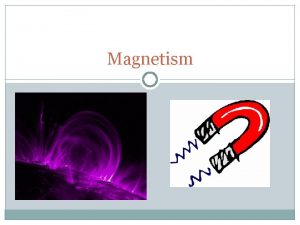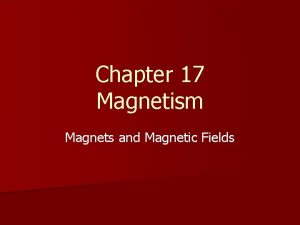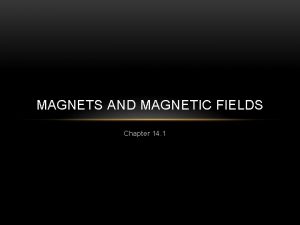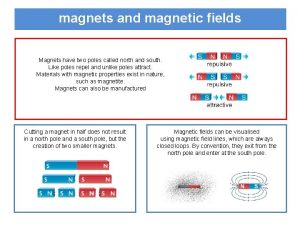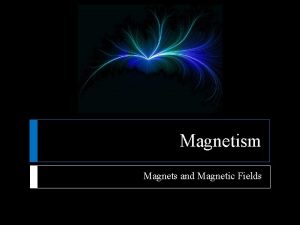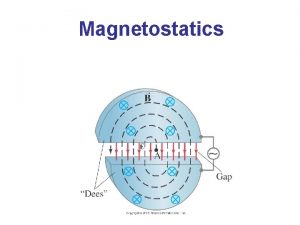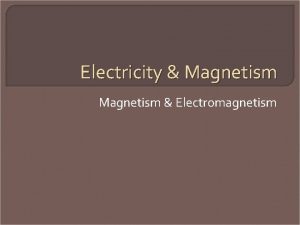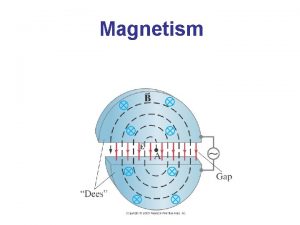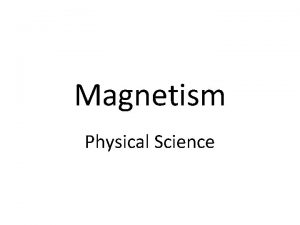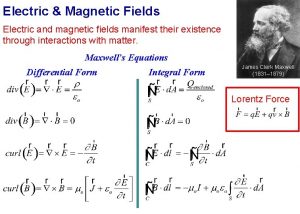Lecture Demos E40 Magnetic Fields of Permanent Magnets
















- Slides: 16

Lecture Demos: E-40 Magnetic Fields of Permanent Magnets (6 A-1) E-41 Oersted’s Experiment (6 B-1) E-42 Force on a Moving Charge (6 B-2) 6 B-3 Magnetic Field around a wire 6 B-10 Forces between parallel conductors

READING QUIZ Magnetic fields are created by wires 1. carrying any kind of electric current 2. only if there is a steady current 3. only when the current is first turned on

Chapter 14: Magnets and Electromagnetism 1. Permanent magnets have opposite poles: like poles repel, opposites attract (North, South). 2. Lines of force exist around magnets (field lines). 3. A current in a wire causes a magnetic field outside of the wire. 4. A current in one wire can cause a force on another currentcarrying wire. 5. Magnetic fields exert a force on a moving charge.

Unlike poles attract one another, and like poles repel one another.

http: //www. geolab. nrcan. gc. ca/geomag/compass_e. shtml http: //www. princeton. edu/~oa/manual/mapcompass 2. shtml

Magnetic field lines produced by a magnetic dipole form a pattern similar to the electric field lines produced by an electric dipole. However, the magnetic field lines form continuous loops.

A magnetic dipole lines up with an externally produced magnetic field just as an electric dipole lines up with an electric field.

The magnetic field of the earth can be pictured by imagining a bar magnet inside the earth, oriented as shown here.

With the wire oriented along a north-south line, the compass needle deflects away from this line when there is current flowing in the wire.

The right-hand rule gives the direction of the magnetic field lines that encircle a current-carrying wire. The thumb points in the direction of the current and the fingers curl in the direction of the field lines.

Two parallel current-carrying wires exert an attractive force on each other when the two currents are in the same direction.

The magnetic force exerted on the moving charges of an electric current is perpendicular to both the velocity of the charges and to the magnetic field.

If the index finger of the right hand points in the direction of the velocity of the charge, and the middle finger in the direction of the magnetic field, the thumb indicates the direction of the magnetic force acting on a positive charge.

Force per unit length on parallel wires: K = 1 x 10 -7 N/A 2 Force on a moving charge: F = qv. B, where F is perpendicular to both v and B. Force on a wire with current I in a perpendicular B field: F = I LB

When a current-carrying wire is bent into a circular loop, the magnetic fields produced by different segments of the wire add to produce a strong field near the center of the loop.

The two most important facts about magnets: 1. Moving a coil of wire near a magnet can cause a current to flow in the wire. 2. Moving a magnet near a coil of wire can cause a current to flow in the wire.
 Scrap heap magnet circuit diagram
Scrap heap magnet circuit diagram Bbc bitesize electric bell
Bbc bitesize electric bell Temporary vs permanent magnets
Temporary vs permanent magnets Difference between permanent magnet and temporary magnet
Difference between permanent magnet and temporary magnet What are magnets made of
What are magnets made of Red fields to green fields
Red fields to green fields Magnetic fields quick
Magnetic fields quick Electric currents and magnetic fields
Electric currents and magnetic fields Learning: module 26: magnetic forces and fields
Learning: module 26: magnetic forces and fields Electric currents and magnetic fields
Electric currents and magnetic fields Magnetic fields in matter
Magnetic fields in matter Difference between antiferromagnetism and ferrimagnetism
Difference between antiferromagnetism and ferrimagnetism Flux unit
Flux unit Magnetic moment and magnetic field relation
Magnetic moment and magnetic field relation F=i(lxb)
F=i(lxb) 01:640:244 lecture notes - lecture 15: plat, idah, farad
01:640:244 lecture notes - lecture 15: plat, idah, farad Atmosfer berasal dari bahasa….. *
Atmosfer berasal dari bahasa….. *


